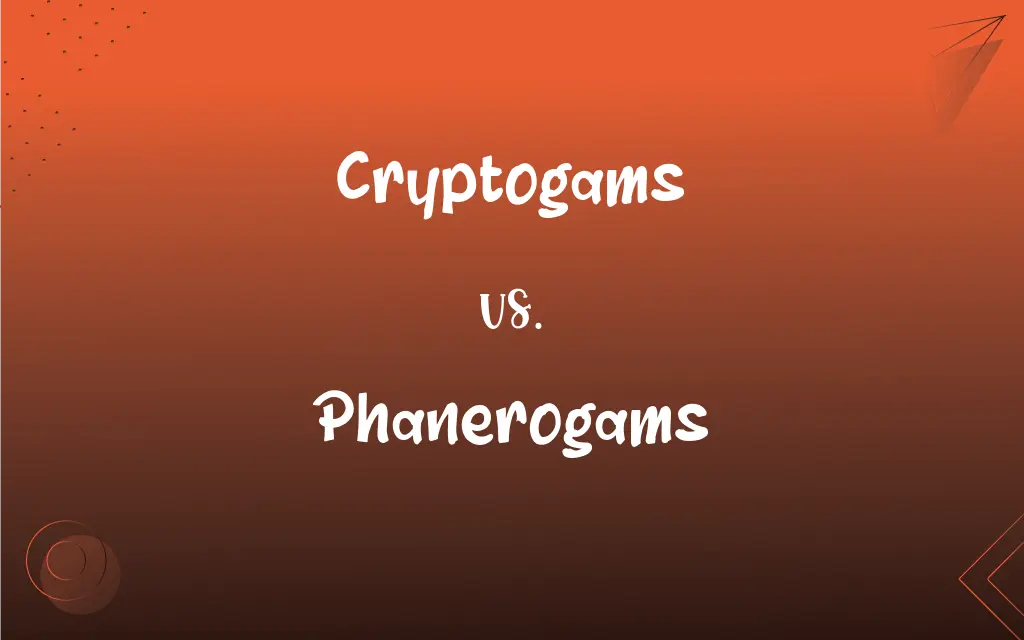Cryptogams vs. Phanerogams: What's the Difference?
Edited by Aimie Carlson || By Harlon Moss || Updated on October 18, 2023
Cryptogams are non-seed producing plants (like ferns and mosses), while phanerogams produce seeds (like flowering plants and conifers).

Key Differences
Cryptogams and phanerogams are two primary classifications of the plant kingdom based on their reproductive strategies. Cryptogams, derived from Greek meaning "hidden marriage," encompasses plants that reproduce without seeds. This category includes algae, fungi, mosses, and ferns. In contrast, phanerogams, meaning "visible marriage," are plants that reproduce via seeds.
Delving deeper into cryptogams, they lack flowers or seeds and reproduce primarily through spores. Mosses and ferns are classic examples, thriving in damp environments, and play significant roles in maintaining ecological balance. On the other side, phanerogams exhibit a clear distinction between their roots, stems, and leaves. Their reproductive organs are more evident, and they primarily reproduce through seeds.
The lifecycle of cryptogams is distinct, typically showcasing an alternation of generations. For example, ferns produce spores on the undersides of their leaves, which develop into a separate gametophyte generation, eventually leading to the formation of the next sporophyte. In contrast, phanerogams, like flowering plants, have a more straightforward lifecycle, transitioning from seed to mature plant capable of producing more seeds.
The significance of these classifications is not just academic. Cryptogams, like mosses, can colonize challenging environments, stabilize soils, and initiate ecological succession. They are critical in many ecosystems, aiding in nutrient recycling and water retention. Phanerogams, with their seed-producing capability, dominate many landscapes. From the towering conifers to flowering plants, phanerogams significantly contribute to biodiversity, ecosystem stability, and serve as a primary food source for numerous organisms.
In essence, while cryptogams signify an ancient lineage of seedless plants that rely on spores for reproduction, phanerogams represent the evolutionary advancement in the plant kingdom, emphasizing seed-based reproduction.
ADVERTISEMENT
Comparison Chart
Seed Production
Do not produce seeds
Produce seeds
Examples
Ferns, mosses, algae
Flowering plants, conifers
Reproduction
Through spores
Through seeds
Presence of Flowers
Lack flowers
Have flowers
Ecological Role
Colonize challenging environments
Dominate many landscapes, contribute to biodiversity
ADVERTISEMENT
Cryptogams and Phanerogams Definitions
Cryptogams
Cryptogams are fundamental for initiating ecological succession.
After a volcanic eruption, cryptogams are often the first to colonize the barren landscape.
Phanerogams
Phanerogams are seed-producing plants.
Oak trees, with their acorns, are classic phanerogams.
Cryptogams
Cryptogams often thrive in damp, aquatic, or humid habitats.
Algae, as aquatic cryptogams, play essential roles in marine ecosystems.
Phanerogams
Phanerogams can be further divided into gymnosperms and angiosperms.
While pines are gymnosperm phanerogams, roses are angiosperm phanerogams.
Cryptogams
Cryptogams are plants that reproduce without seeds.
Mosses are cryptogams that thrive in moist environments.
Phanerogams
Phanerogams dominate many terrestrial ecosystems.
The Amazon rainforest is densely populated with phanerogams, providing habitat for countless species.
Cryptogams
Cryptogams predominantly rely on spores for reproduction.
The underside of fern leaves releases spores, aiding in cryptogams' reproductive cycle.
Phanerogams
Phanerogams have distinct reproductive organs, typically flowers.
The vibrant flowers of cherry trees are reproductive structures characteristic of phanerogams.
Cryptogams
Cryptogams encompass seedless vascular and non-vascular plants.
Ferns, as vascular cryptogams, have specialized tissues for transporting water and nutrients.
Phanerogams
Phanerogams have a clear differentiation between roots, stems, and leaves.
The phanerogams' structure, like that of the maple tree, allows for efficient photosynthesis and nutrient transport.
Cryptogams
A member of a formerly recognized taxonomic group that included all seedless plants and plantlike organisms, such as mosses, algae, ferns, lichens, and fungi.
Phanerogams
A plant that produces seeds.
Cryptogams
Plural of cryptogam
Phanerogams
Plural of phanerogam
FAQs
Do cryptogams produce flowers?
No, cryptogams do not produce flowers.
How do cryptogams reproduce?
Cryptogams reproduce by means of spores rather than seeds.
What are cryptogams?
Cryptogams are non-seed bearing plants that reproduce by spores.
What are the main divisions of cryptogams?
algae, fungi, and bryophytes (mosses and liverworts).
Can cryptogams be found underwater?
Yes, many types of algae, which are cryptogams, are aquatic.
What's the economic importance of cryptogams?
Cryptogams, especially algae and fungi, play vital roles in ecosystems, food chains, and some even have commercial uses.
Do phanerogams produce flowers?
Angiosperms, a subset of phanerogams, produce flowers. However, gymnosperms do not.
What's the difference between gymnosperms and angiosperms?
Gymnosperms produce naked seeds (not enclosed within a fruit), while angiosperms produce seeds enclosed within a fruit.
What are phanerogams?
Phanerogams are seed-producing plants.
How are phanerogams classified?
Phanerogams are broadly classified into two groups: gymnosperms and angiosperms.
Do phanerogams have vascular tissues?
Yes, phanerogams possess well-developed vascular tissues.
What are the reproductive organs of angiosperms?
Angiosperms have flowers as their reproductive organs.
Are all phanerogams flowering plants?
No, only angiosperms are flowering plants. Gymnosperms are non-flowering phanerogams.
Are all fungi considered cryptogams?
Yes, fungi are a part of the cryptogamic division as they reproduce by spores.
Are cryptogams multicellular or unicellular?
While many cryptogams like algae can be unicellular, others like mosses are multicellular.
How do phanerogams reproduce?
Phanerogams reproduce via seeds.
Are conifers considered phanerogams?
Yes, conifers are gymnosperms, which are a type of phanerogam.
What's the economic importance of phanerogams?
Phanerogams, especially angiosperms, are vital for human sustenance, providing food, medicine, timber, and other resources.
Are ferns considered cryptogams?
Traditionally, ferns were grouped with cryptogams, but they are now classified as pteridophytes. They're seedless but have vascular tissue.
Do cryptogams have vascular tissues?
Bryophytes, a group of cryptogams, lack true vascular tissues, while some other cryptogams might have primitive vascular structures.
About Author
Written by
Harlon MossHarlon is a seasoned quality moderator and accomplished content writer for Difference Wiki. An alumnus of the prestigious University of California, he earned his degree in Computer Science. Leveraging his academic background, Harlon brings a meticulous and informed perspective to his work, ensuring content accuracy and excellence.
Edited by
Aimie CarlsonAimie Carlson, holding a master's degree in English literature, is a fervent English language enthusiast. She lends her writing talents to Difference Wiki, a prominent website that specializes in comparisons, offering readers insightful analyses that both captivate and inform.
































































